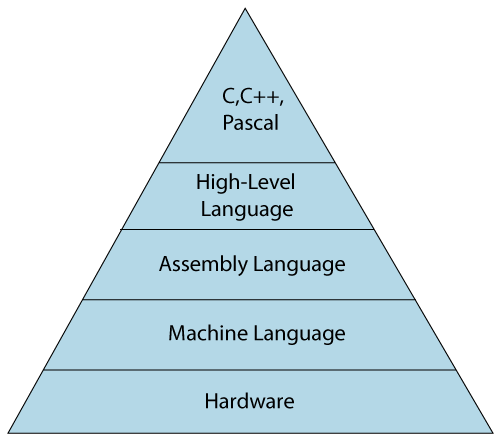A programming language defines a set of instructions that are compiled together by the Central Processing Unit (CPU) to perform specific tasks. Programming languages mainly refer to high-level languages such as C, C++, Pascal, Ada, and COBOL.
Each programming language contains a unique set of keywords and syntax used to create a set of instructions. Thousands of programming languages have been developed to date, but each language has its specific purpose. These languages differ in the level of abstraction they offer. Some programming languages provide little or no abstraction, while others offer a higher level of abstraction. Based on the level of abstraction, they can be divided into two categories:
-
Low-Level Languages
-
High-Level Languages
The image below describes the level of abstraction from hardware. As shown in the figure, machine language provides no abstraction, assembly language provides little abstraction, while high-level languages provide a higher level of abstraction.

Low-Level Languages
Low-level languages are programming languages that do not provide abstraction from hardware, instead representing instructions in the form of 0s and 1s, which are machine instructions. Languages that fall into this category include machine-level languages and assembly languages.
👇Click to receive👇
👉C Language Knowledge Resource Collection
Machine-Level Language
Machine-level language consists of a set of instructions represented in binary form. Since computers can only understand machine instructions, these instructions must be in binary code, that is, 0s and 1s. Writing programs in machine-level language is a very difficult task because it is not easy for programmers to write programs in machine instructions. Due to the difficulty of understanding, maintenance is also very high. Machine-level languages are not portable because each computer has its machine instructions, so a program written on one computer will not be valid on another.
Different processor architectures use different machine codes; for example, the PowerPC processor contains a RISC architecture that requires different code than the Intel x86 processor.
Assembly Language
Assembly language includes commands that are somewhat more readable, such as mov, add, sub, etc. Assembly language reduces some of the issues encountered in machine-level language to a certain extent. Because assembly language instructions are written in English-like words such as mov, add, and sub, it is easier to write and understand.
Since computers can only understand machine-level instructions, a converter is needed to translate assembly code into machine code. The converter used to translate the code is called an assembler.
Assembly language code is not portable because data is stored in computer registers, and the computer must know the different sets of registers.
Assembly code is no faster than machine code because assembly language is above machine language in the hierarchy, meaning assembly language has a higher degree of abstraction from hardware, while machine language has zero abstraction.
Differences Between Machine-Level Language and Assembly Language
The differences between machine-level language and assembly language are as follows:
| Machine-Level Language | Assembly Language |
|---|---|
| Machine-level language is at the lowest level of the hierarchy, so its level of abstraction from hardware is zero. | Assembly language is above machine language, meaning it has a lower level of abstraction from hardware. |
| It is not easily understood by humans. | It is easy to read, write, and maintain. |
| Machine-level language is represented in binary bits, that is, 0s and 1s. | Assembly language is written in simple English words, making it easy for users to understand. |
| No converter is needed because computers directly understand machine code. | Assembly language requires an assembler to convert assembly code into machine code. |
| It is the first generation of programming languages. | It is the second generation of programming languages. |
High-Level Languages
High-level languages are programming languages that allow programmers to write programs independent of specific computer types. High-level languages are called high-level because they are closer to human language compared to machine-level languages.
When writing programs in high-level languages, the focus needs to be on the logic of the problem.
Converting high-level languages into low-level languages requires a compiler.
Advantages of High-Level Languages
-
High-level languages are easy to read, write, and maintain because they are written in simple English words.
-
High-level languages are designed to overcome the limitations of low-level languages, namely portability. High-level languages are portable, meaning these languages are machine-independent.
Differences Between Low-Level Languages and High-Level Languages
The differences between low-level languages and high-level languages are as follows:
| Low-Level Languages | High-Level Languages |
|---|---|
| It is a machine-friendly language, meaning computers understand machine language, represented in 0s and 1s. | It is a user-friendly language because it is written in simple English words that are easy for humans to understand. |
| Low-level languages execute more slowly. | They execute at a faster speed. |
| It requires an assembler to convert assembly code into machine code. | It requires a compiler to convert high-level language instructions into machine code. |
| Machine code cannot run on all machines, so it is not a portable language. | High-level code can run on all platforms, thus it is a portable language. |
| It is memory efficient. | It has lower memory efficiency. |
| Debugging and maintenance in low-level languages are not easy. | Debugging and maintenance are easier in high-level languages. |

Popular Recommendations
-
C Language Tutorial – Detailed Explanation of the Data Segment in C
-
C Language Tutorial – Detailed Explanation of the Execution Process in C
-
C Language Algorithm – “Search Rotated Sorted Array” Algorithm Problem